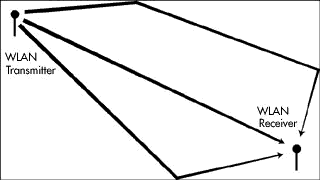| Wireless LAN Specifications and Considerations |
Range/Coverage
The distance over which RF and IR waves can communicate related to product design (including transmitted power and receiver design) and the propagation path, especially in indoors. Interactions with typical building objects, including walls, metal, and even people, can affect how energy propagates, and thus what range and coverage a particular system achieves. Solid objects block IR, which provides additional limitations. Most wireless LAN systems use RF because radio waves can penetrate many indoor walls and surfaces. The range of coverage for typical WLAN systems varies from under 100 feet to more than 300 feet. Coverage can be extended, and true freedom of mobility via roaming, provided through microcells.
Throughput
As with wired LAN systems, actual throughput in wireless LANs is product and set-up dependent. Factors that affect throughput include airwave congestion (number of users), propagation factors such as range and multipath, the type of WLAN system used, as well as the latency and bottlenecks on the wired portions of the WLAN. Typical data rates range from 1 to 10 Mbps. Users of traditional Ethernet LANs generally experience little difference in performance when using a wireless LAN and can expect similar latency behaviour. Wireless LANs provide throughput sufficient for the most common LAN-based office applications, including electronic mail exchange, access to shared peripherals, and access to multi-user databases and applications.
Multipath Effects
As the diagram below shows, a radio signal can take multiple paths from a transmitter to a receiver, a feature called multipath. Reflections of the signals can cause them to become stronger or weaker, which can affect data throughput. Some designs and technologies are better at compensating for multipath effects than others.

Signal Multipath
Integrity
Wireless data technologies have been proven through more than fifty years of wireless application in both commercial and military systems. While radio interference can cause degradation in throughput, such interference is rare in the workplace. Robust designs of proven WLAN technology and the limited distance over which signals travel result in connections that are far more robust than cellular phone connections and provide data integrity performance equal to or better than wired networking.
Interoperability with Wired Infrastructure
Wireless data technologies have been proven through more than fifty years of wireless application in both commercial and military systems. While radio interference can cause degradation in throughput, such interference is rare in the workplace. Robust designs of proven WLAN technology and the limited distance over which signals travel result in connections that are far more robust than cellular phone connections and provide data integrity performance equal to or better than wired networking.
Interference and Coexistence
The unlicensed nature of radio-based wireless LANs means that other products that transmit energy in the same frequency spectrum can potentially provide some measure of interference to a WLAN system. Microwave ovens are a potential concern, but most WLAN manufacturers design their products to account for microwave interference. Another concern is the co-location of multiple WLANs. While WLANs from some manufacturers interfere with WLANs, others coexist without interference.
Simplicity/Ease of Use
Users need very little new information to take advantage of wireless LANs. Because the wireless nature of a WLAN is transparent to the user and applications work the same as they do on wired LANs. WLANs simplify many of the installation and configuration issues that annoy network managers. Since only the access points of WLANs require cabling, network managers are freed from pulling cables for WLAN end users. Lack of cabling also makes moves, upgrades, and changes trivial operations on WLANs. Finally, the portable nature of WLANs lets network managers preconfigure and troubleshoot entire networks before installing them at remote locations. Once configured, WLANs can be moved from place to place with little or no modification.
Security
Because wireless technology has roots in military applications, security has long been a design criterion for wireless devices. Security provisions are typically built into wireless LANs, making them more secure than most wired LANs. It is extremely difficult for unintended receivers (eavesdroppers) to listen in on wireless LAN traffic. Complex encryption techniques make it impossible for all but the most sophisticated to gain unauthorised access to network traffic. In general, individual nodes must be security-enabled before they are allowed to participate in network traffic.
Cost
A wireless LAN implementation includes both infrastructure costs, for the wireless access points, and user costs, for the wireless LAN adapters. Infrastructure costs depend primarily on the number of access points deployed; access pointís range in price from £1,500 to £2500. The number of access points typically depends on the required coverage region and/or the number and type of users to be serviced. The coverage area is proportional to the square of the product range. Wireless LAN adapters are required for standard computer platforms, and range in price from £500 to £2,000.
The cost of installing and maintaining a wireless LAN generally is lower than the cost of installing and maintaining a traditional wired LAN, for two reasons. First, a WLAN eliminates the direct costs of cabling and the labour associated with installing and repairing it. Second, because WLANs simplify moves, upgrades, and changes, they reduce the indirect costs of user downtime and administrative overhead.
Scalability
Wireless networks can be designed to be extremely simple or quite complex. Wireless networks can support large numbers of nodes and/or large physical areas by adding access points to boost or extend coverage.
Safety
The output power of wireless LAN systems is very low, much less than that of a hand-held cellular phone. Since radio waves fade rapidly over distance, very little exposure to RF energy is provided to those in the area of a wireless LAN system. Wireless LANs must meet stringent government and industry regulations for safety. No adverse health affects have ever been attributed to wireless LANs.
| Send comments to webmaster Copyright © 1997 Derek Mc Donnell. All Rights Reserved. Last updated 07-Apr-1998. |
 |